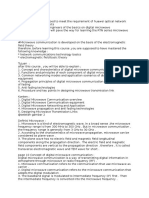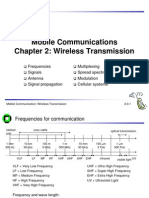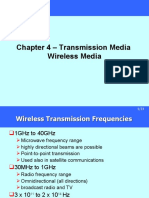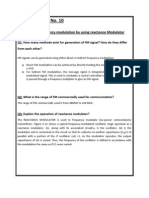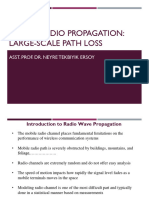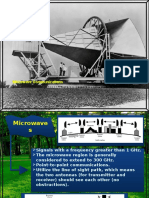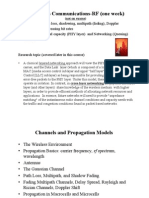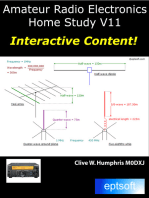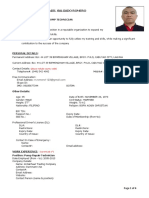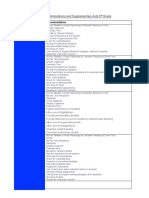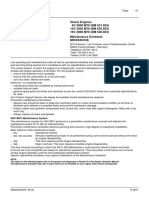MW English)
MW English)
Uploaded by
Karnnan KamarajCopyright:
Available Formats
MW English)
MW English)
Uploaded by
Karnnan KamarajCopyright
Available Formats
Share this document
Did you find this document useful?
Is this content inappropriate?
Copyright:
Available Formats
MW English)
MW English)
Uploaded by
Karnnan KamarajCopyright:
Available Formats
Microwave relay communication and
transmission project design
2007.6.1
DIFFERENT TRANSMISSION METHODS
MUX
Satellite
Fiber-optics cable
Microwave
Coaxial cable
MUX
1. Microwave relay communication
Microwave is the high frequency of radio wave. The frequency band
is from 300MHz to 300GHz. In this bandthe frequency is higher ,the
wavelength is lower(1m0.1mm),the attenuation is more when
transmit along the groundthe capability is less. If facing to the barrier
it cant echo when deliverring to the ionosphere. So, the radio wave can
only transmit directly in the stadia.
Frequency Range for microwave300MHZ 300GHZ
Wavelength 1m~1mm
Band: UHF: 0.3-1.12G X8.2-12.4G S2.6-3.95 G Ka:26.5-40G
C3.95-5.85G U: 40-60G L: 1.12-1.7G KU12.4-18G
LS1.7-2.6 G K: 18-26G XC5.85-8.2G
10Km 1Km 100m 10m 1m 10cm 1cm 1mm
f 30KHz 300KHz 3MHz 30MHz 300MHz 3GHz 30GHz 300GHz
LF MF HF VHF UHF SHF EHF
microwave
Microwave relay communication
Radio link struction
Each site can be up and down the informationcan contact with
any station in the network. If each station connect with the So all
can communication with each other.
The radio link propagation follows the line of sight: it requires a perfect clearing between transmiting
and receiving antennas. The propagation medium is made of the lower layers of the atmosphere
(a few meters to a few hundred of meters above ground)
The non homogeneity of the atmosphere influences the waves propagation:
1) Path curvature
2) Reflecting, diverging, focusing intermittent events
System table
Repeater Site
PNMS
Branch Site
Local Wiring
Terminal Site
Radio link
A
B
C
D
E
F
PABX
Router
PABX
WAN
Attributes of Digital Microwave
The signal which transmit by microwave is digital signal
So it both have digital and microwaves attributes
1Rapid deployment over difficulty terrain
2Economical
3High route security
4. Network simpleness and flexile .
5. Robust to fading and interference.
6. highly efficient data and broadband transport
Channel selection
1Channel divide
f0 fn' f3' f2' f1' fn f3 f2 f1
m
useable frequency divide by some channelAs follow
table In the table f1, f2,fn and f1, f2,fn is the center
frequency of each channelsuch as f1 is down channel
the other is up channel
The suggestion of microwave relay communication by
CCIR is at 283-4,382-2,384-3,385-2,386-2,387-3492-2
FREQUENCY SHIFT BETWEEN CHANNELS
ANALOG
DIGITAL
1800 channels MF 140 kHz rms/channel ~ 30 MHz
CAPACITY MODULATION DEVIATION
2700 channels MF 140 kHz rms/channel ~ 40 MHz
30 channels 2 Mbit/s 4 PSK 3.5 MHz
120 channels 8 Mbit/s 4 PSK 7 MHz
480 channels 34 Mbit/s
4 QAM 30 MHz
16 QAM 14 MHz
1920 channels 140 Mbit/s
16 QAM 40 MHz
64 QAM 30 MHz
Generally two couple channel needed when construct a new trunk
channel need added at the across Otherwise system disturb will produce it
will hard to communication
aWhen the radio link have same route link or nearly linkkeep away from it
is the best choice If we have calculated the disturb is little and spare is enough
we can use the same channelbut polarization must different
bWhen it have across linkif across angle is lessen tha 30treated as a
if across angle is more than 60 so select the channel which hve used in order
to save frequency source
cIn order to avoid disturbthe fourth sattion cant be in the extend line of
the first and secondthe arrange of polarization is H,V,V
dFrequency must avoid the which used by local radar and satellaite
e.The frequency should authorize by local goverment
2Rule of channel selection
f1
f1
f2
f1
H H V
Classify of microwave station
1Communication struction
2CLASSIFY
aClassify by station type
Terminal stationAt the end of radio linkonly can
communication in one way
Relay stationBetween two station of radio linkcan
communication in two way.
Hinge stationIn the centre of radio linkcan
communication in three way
bClassify by frequency
High stationreceive frequency higher than send
Low stationreceive frequency lower than send.
MICROWAVE RADIO LINK
TX/R
x
Terminal
Station
Relay station
(Active)
Hop
NO.1
or
Relay station
(Passive)
TX/Rx
Terminal
Station
Cable
Cable
Radio link
Distance between the transmitter and the receiver, some km < D < 100 km
Availability and quality are depending on distance according I.T.U.R. rules
Hop
NO.2
Hop
No.n
TX/R
x
TX/R
x
Microwave equipment
aStructure pange table
Source
encode TX BB MOD
UP
CONV
PWR
AMP
BR
CKT
SYN
RX decode RX BB DEM
DOWN
CONV
LNA
BR
CKT
(Modulator )
(Demodulator )
TX Rx
Antennas
IF
UHF/SHF
BB : Base band
Base band
IF : Intermediate Frequency
UHF : Ultra-High Frequency (300 - 3000 MHz)
SHF : Super-High Frequency (3000 - 30.000 MHz)
MICROWAVE LINK STRUCTURE
RADIO-RELAY STATION - PROTECTION
HV lightning
Lightning rod
Ground network
Tower ground
Fence
HV line
Transformer
MV circuit-breaker
Power panel
MV lightning diverter
Iron structure connected
to ground network
bMAIN FEATURE
1Output power (dB m) Ptthe power of tx which decided
by path distance ,use purpose of equipment and so on
2Frequency stability of txthe ratio of fact tx frequency
and standard work frequency
3Branch loss of TX (dB) Lf: Loss between TXand
transmission line
4Rx signal (dB m) Pth: the lowest rx signal of receiver
5Frequency stability of receiver the stability of receivers
self frequency
6Receiver branch loss Lsthe RF signal come from
transmission line to receiver
7. Capacity: 1 4 8 16 155
TRT PRODUCTS
Tx/Rx
CMI
Tx/Rx
HDB3
Tx/Rx
HDB3
Tx/Rx
HDB3
1
4
3
2
1
4
3
2
TN2
1
4
3
2
1
30
140 Mbit/s
34,268 Mbit/s
8,448 Mbit/s
2,048 Mbit/s
64 kbit/s
34 Mbit/s
8 Mbit/s
2 Mbit/s
Tx/Rx
TN4
2/34 Mbit/s PDH
ADM
155
155 Mbit/s
CMI
4x2 Mbit/s
or 4x2 Mbit/s
or 16x2 Mbit/s
TN3
TN1
The line from receiver branch system to transmit
antenna we called transmission line
1The requirement of transmission loss must
lowerb restrict energyprevent radiate
2Type of transmission lineaCoaxial lineb
Empty waveguide
3Main feature loss of each meter dB/m
ELLIPTICAL WAVEGUIDES
Use: outdoor installation (pressurized waveguides)
Loss: useful formula for
standard waveguides
A.dB/meter ~
F Ghz
100
plastic envelop
Semi-rigid brass elliptical waveguide
Length:
120 meters
20lgP( )
a
0
10 5 0 5 10
-25
-20
-15
-10
-5
ANTENNA
1Action of antennareceive or send radio wave which bring
information
2Main feature:
a. Half power angleat antenna direct mapThe angle relative to
principal axis direction which is the half power
1.03/D(radian) : wav legth D: antenna diameter
b. Gainin the case the same intensity electric produce at space
The ratio between Ideal input power and fact input power
G=4D/(. ) D: diameter wave length using coefficient
PARABOLIC ANTENNAS
Parabolic
reflector
Polar. H
Polar. V
Radme
(Reduction of backward
and side-lobe radiation > 15 dB)
u3 dB ~ 58 /R (uniform illumination)
Gain = 10 log 0.55
( )
t2R
Polarization decoupling H/V, XPD > 30 dB
2
R
High performance
antenna
Skirt + Radome
+
Site and
azimuth
orientation
Radiation Pattern Envelop of Antenna
Radiation Pattern Envelop of Antenna
Antenna Performance
IRON TOWER
REQUIREMENT
1Antenna heights requirementaccord with the rule of air
departmentin the peak of tower have aviation symbol
2Have enough intensionCan endure load build on it (such
as windrainsnow)the swing angle at the location of antenna
less than/2(is antenna half power angle)
3Grounding resistanceless than 5Ohmlightning rod must
build in the top
name spec Net weightKG
WTG03-71DAR 0.3m 11.5
WTG06-71DAR 0.6m 14
WTG12-71DAR 1.2m 43
WTG16-71DAR 1.6m 68
WTG20-71DAR 2.0m 117
WTG25-71DAR 2.5m 190
WTG32-71DAR() 3.2m 280
2Radio wave transmit
Radio wave transmit in the free space
1Transmit loss of free space
Free space is a perfect infinity vacuum spaceRadio
wave cannot bring reflectingrefractionand dispersion
When radio transmit in free spaceloss will cause Distance
more farenergy received less The fade caused by radio
wave transmit is called free space lossThe formula is
2RX Signal in free space
) ( lg 20 ) ( lg 20 4 . 92
0
GHz f km d L + + =
GHz f
0
) ( ) ( L L L L G G P P
Er r t t t t ro
+ + + =
; dBm P
t
; dB G G
t t
; dB L L
t r
; dB L
Er
In fact the space which radio wave transmit by I not free
space In this coursereflect caused by grounddispersion by
particle of the atmosphereIn a word the medium and object
on the circuitry will bring influence for the range and phase of
radio wave
Attenuation feature of radio wave transmit
1ATTENUATION
The irregularly change of receiver
a). classify by attenuation mechanism
dispersion K typechannel and mix .mostly factor is
refractive index is changed with time ,location ,heightsin a word
attenuation have someth with terrain and time
b). Classify by attenuation time
Quick attenuationThe duration is several ms a small s
Slow attenuation The duration is seconds to hours
c). Classify by eletricity calm
up attenuationreceive calm more than in free space
down attenuation receive calm less than in free space
2Change rule of attenuation
a). Frequency more higherpath distance more longerattenuation
Is more serious
b). nighttime is more serious than daytimesummer is more
serious than winter
c). sunshine windless is more than cloudy rain day
(dB/Km)
1GHz 7.5GHz 12GHz 23GHz 60GHz
0.01dB
10dB
1dB
0.1dB
d)circuitry on water is more serious than on land
e)circuitry on plain is more serious than hill
f)when sun sunrise and sundownfade is serious
3the product mechanism of attenuation
a) absorb by atmosphere
any physical molecule is make up of particleeach
particle have its frequency when the frequency across is
near its self so resonate absorb is producedStatistics
indicate atmosphere absorb can ignore when frequency
blow 12GHzabsorb blow 1dB
b). Fade of rain
The little rain drop can cause dispersion to radio wave
statistics indicate rain and fog have little effect to 10GHz
micro wave ,but have great effect to micro wave above 10GHz
rainfall different have much effect to micro wave
Even cause communicate break
c)attenuation by dispersion
This margin is caused by press of atmospherethe
particle formative by temperature humidity different with
all round so dispersion is caused
K
d)Fade of k
its caused by multipath transmit, its caused by
stright and ground reflect which arrived at
receiver ,phase is different
when circuitry designshould avoid circuitry
across great water and open plain
e)Fade of channel
effect by climate such ground burnt in the day cool in
nightWhen radio wave across refraction caused
fmixed fade
Involve of k fade ,channel fade atmosphere fade
Ways of avoid fade
when fade is caused SRN is lowerdeep fade may
cause communication breakIn order to make sure
transmit quality and reliabilitymust adopt some
measure to avoid fade
1Frequency diversity
Frequency diversity is which adopt two or more
frequency which have a distance send and receive the
same signal at the same time next compose or select
lighting the effect of fade
disadvantage is effect better only need one couple of
antenna But frequency have not make full use of
requirement for frequency frequency relativity is little
10 /
10
*
8 . 0
Fd
f
f
d f
I
A
=
f/f-
2GHzf11GHz; 30kmd70km; f/f5.
I5
ODU x2
1+1 IDU
IF Cable
Hybrid
Antenna
REAR VIEW
ODU #1 ODU #2
Hybrid
to ODU #1
to ODU #2
1+1 IDU
IF Cable
RF Coaxial Cable
Hybrid
Antenna
ODU #1
ODU #2
RF CABLE CONNECTION
2 SPACE DIVERSITY
Diversity is that one frequency received by two or more antenna which
is not the same size, next copose or select a stronger signal
The advance of frequency diversity is can improve effect
economic frequencyBut equipment complex ,need tow couple
antenna is its disadvantage.
The key of space diversity is make sure two couple of antenna is
appropriate, altitude difference is enoughso antenna can work in
reverse phasic when decline is appearnow the decline can avoid
p1 p2
( ) | |
10 / ) V Fd ( 04 . 1 48 . 0 12 . 0 87 . 0 4
10 p d F S 10 34 . 3 exp 1 I
=
2 1
G G V =
Fd-Pdb.
p
SPACE DIVERSITY
Principle
dB
hm
h1
h2
F1
h1
h2
F1 F1
d
>
1
0
0
Combineur
Combined IF output
Receivers
Path
equalization
Two operating modes:
1 - minimum distorsion for an high level received
2 - maximum power for a weak level received (s - 65 dBm)
N
N
(F1)
(FI)
R1
R2
Climatic reflection
t
o
1
5
0
1+1 IDU
IF Cable
Main Antenna
ODU #1
ODU #2
Div. Antenna
SPACE DIVERSITY SYSTEM
1+1 IDU
IF Cable
Main Antenna
ODU #1
ODU #2
Div. Antenna
RF Coaxial Cable
SPACE DIVERSITY SYSTEM
3 Angle diversity
Angle diversity use the same antenna send the same signal with
use two antenna receive main signal at receive side
the feature is two main wave received are different effect is
better , but complex
4 Polarization diversity
ITS using the same antenna send the same signal with two
polarizationone antenna receive polarization signal at receive side
next composed
5Mix diversity
combination with frequency diversity and space diversity
5 Avoid reflection by terrain
by the best design of antenna heightsreflection wave avoid
or in the ground which reflectance is little
statistics feature of fade
stat indicatemargin and terrain have relate with path length
Terrain and path length different margin is different
1Path distance d
The rule is d more longerAttenuation is more d more shorter
Attenuation is lessen sothe relay distance relay on the parameter of the
equipment such as work frequencyterrainclimateantenna heights and
some test datagenerallythe region which transmit condition is betterD can be
longerotherwise D cant be too long
Besides also should calculate D too long or too short will bring receive
electric calm is too high or too lowReceive signal above normalReceive signal
blow normalTwo case can bring error code increasesometime communication
will break
so when have no fade circuitry design must enable the
difference between receiver signal an normal less than 6dB2
profile
Relay on terrain, climate, antenna heightsthe profile can
divided four type
A(HILL)Its made up of hill ,building, no rain and lakeThe
reflectance is less than 0.5
B hillThe profile is make up of hill which is not toobighave no big river and
lake The reflectance of this circuitry blow 0.7the receive electric calm bring up by
ground reflect is less than 10 DB
C plainThe profile is make up of flat ,water
The profile is which more plain or water reflectance is more than 0.7The rx
signal decline than 10db is caused by ground reflectWater more the multipath
fade is more serious by atmosphere asymmetry
D seaMake up of sea most above the waterThe attenuation caused by
atmosphere asymmetry is more serious of this kind circuitry which is the badly
circuitry transmit for radio wave
The mission of microwave circuitry design is avoid the profile of cDselect A
BIf difficulty to implementso need add diversity and protect,or select the
equipment which have resist mutipath
3Stat rule of attenuation
After great test and satthe attenuation of microwave rule with ruilin
distributingIts feature is quick and deepWhen the rule used in
microwave communicationin the view of condition of transmit the
formula is
10 / Fd
N
10 P P
=
c B
R
d Qf k P
1
=
Design is at the base of reconnaissance the tool need is :
1. GPS satellite receiver 1
2. compass 1
3. ruler 30 M
4. 1/50000 Relief map
5. Magnifier 1
6. Pencil, Eraser
7. Frequency chart 1
8. Microwave transmitter 1
9, Test antenna 2side
3TRANSMIT PROJECT DESIGN
In microwave circuitry design two work is important one is select suit antenna
heightsthe other is calculate by circuitry break ratedecided the configure of equipment
and frequency
Design of antenna heights
The newly contract circuitryantenna heights is an inportant factor of communication
If antenna heights is not suitablythe equipment is advancedalso difficulty to get better
quality of communication
The design of antenna heightsthe most is control the spare of circuitrymake sure
reflect wave is avoid or reflect point is at the ground which k is small.
1Spare atandard
KKmin Hc/F10.3 for the barrier like knife k=0
K4/3 Hc/F10.6
K Hc/F1<1.35
when calculate sparethe heights of building and tree on the circuitry I also
consider
Select of circuitry work point
0 -0.5 -1.0 0.5 1
1.5
2 2.5
-40
-30
-20
-10
0
Vdb
0.577 1.414
Hc/F1= n
6
A
B
h
1
h
2
d
d
1
d
2
hp
hc
hs
M
F
h3
h4
h5
h6
2
0
10D
2
0
17.1*D*D/
D
2Requirement of near antenna region
a)paraboloid antenna
widen terrain
1m antenna antenna heights is 4.1m
1.5m antenna antenna heights is 6.2m
2m antenna antenna heights is 8.3m
3.2m antenna antenna heights is 13.2m
b)
<50m <50m
5
D=d1+d2 d2=
D D
d1=
h
2
d2 d1
h
1
h1
h1+h2
h2
h1+h2
3calculate of reflect point
the purpose of calculate reflect point is control its location,
adjust by antenna heightsavoid reflect point on water or the region
which reflectance is height
generallyimprove the stability need avoid the line of reflect
Smoothly ground
h
1
h
2
d1
d2
terrain of sphericity
) 240 3 / cos( q 2 2 / d d
1
+ | + =
) km (
) q q / ( cos
1
= |
4 / ) h h ( K 5 . 8 ) 12 / d ( q
2 1
2
+ + =
4 / ) h h ( Kd 37 . 6
1 2
=
We can draw conclusion from above formulareflect pointd1(d2)is
the function of antenna heights control antenna heights the reflect point
is also controlreflect point also is the function of kthe value of k is
change with terrainso reflect point also is a regionthe purpose of
antenna heights design is avoid reflect region in the region of reflectance
64kb/s 64kb/s
27500km
Break rate of circuitry
circuitry design high error code is the design feature
Because if high error code is satisfy the lower also can
satisfy.
1reference circuitry
Suggestion by CCIRfor digital link and circuitry which
capacity is 64kthe longest circuitry can reach27500Km
make up by three grade channelas follow chart
The total length of highness digital channel is 2500km
main application is international and inter trunk
Intermediate is 1250kmmain application is inter branch
The customer channel is 50kmmain apply in local digital
switch and links between 64kb/s customer
2Digital microwave channel feature
high circuitry (2500km)
The time which in any month one seconds error rate than 1E-3
less than 0.054
middle circuitry(1250km)
The time which in any month one seconds error rate than
1E-3 less than 0.04.
consumer circuitry(50km)
The time which in any month one seconds error rate than
1E-3 less than 0.015
3Target assign
Consider relay path is different the longer is more easy to
breakSo CCIR930 suggest the break feature should assign to
every sect
% 054 . 0
2500
=
D
P
e
% 04 . 0
1250
=
D
P
e
high
circuitry
Middle
circuitry
Consumer circuitry 0015
Common circuitry calculate
.Location selection and route profile
The hill and mountain forest which altitude difference more is the
best choice for route selectionone side higherthe other lower
shape highlow model circuitrythe better is have hill which up
and down but cant avoid line of sight the profile is indentation, so the
radio wave avoided reflection decline. the location satisfy that case
close the place which living ,traffic ,power is convenient as possiblein
order to maintenance economic invest
Many other factors should be consider , such as disturb by route
radarThunder in the region should also be consider ,lightning rod
should build.
Relay on profile data ,draw profile mapaccording to
spare stand to decide antenna heights
Follow question must attentivethe circuitry reflect more
adjust antenna heights avoid reflect or reflect point at the
ground reflectance is small
antenna azimuth angle
( ) ( ) | | { }
1 2 1 2 1 1 2
1
A
cos sin tg cos / sin tg e e e e = o Z
2 2 1 1
B A e e
Pth
t
Pr
P
. Transmit attenuation in free space
) lg( 20 4 . 92
0
f D L + =
. RX signal of free space
0
) ( ) ( L L L L L G G P P
br bt fr ft r t t r
+ + + + =
.Average margin
th r
F P F =
The conclusion drew from that chart is fade reserve
morethe possibility of incept calm decline to limited is less
So add margin reserve can improve system featureThe
way add such as increase the output power transmitter
increase gain of antenna
.calculate the probability of circuitry breaken
P P P P
.calculate the value of circuitry target
% 04 . 0
1250
=
d
P
p
.Calculate target Spare
P
P
M
p
lg 10 =
IF M>3dB Proper
IF M<3dB Inproper
adjust output powerincrease antennaadd
shorten path distance
The link frequency above 10GHzrain Attenuation should
calculatein order to meet the performance
After the spare of link performance is enoughthe work
such as equipment frequency configure should take out
Path condition
KQ
B
C
Mountain(Re<0.5)
1.07210
-4
1
1.30
Hill(0.5<Re<0.7)
2.7510
-5
1
1.80
Plain(Re>0.7)
2.88410
-5
1
2.20
Sea
2.63010
-6
1
3.20
10 / Fd c B
1
10 d Qf K P
=
Equipment configuration
At the case of power is decided, the size of antenna is the main
factor which is lie on path distance , generally require loss
above 30--35dBmWhen the terrain is plain,the rule of antenna
configuration is :
path distance Km diameter m diameter m
<10Km 0.6 0.6
10<D<16 0.6(1.2) 1.2(0.6)
16<D<25 1.2 1.2
25<D<30 1.5(1.2) 1.2(1.5)
30<D<36 1.5 1.5
36<D<40 1.5(2.0) 2.0(1.5)
40<D<45 2.0 2.0
45<D<48 2.4(2.0) 2.0(2.4)
48<D<50 2.4 2.4
If profile is better ,such as hill and mountainous, so diameter
can minish ;if profile is water ,so need enhance .
You might also like
- Massey Ferguson MF 565 TRACTOR (GB) Service Parts Catalogue Manual (Part Number 819647)Document15 pagesMassey Ferguson MF 565 TRACTOR (GB) Service Parts Catalogue Manual (Part Number 819647)qlb898316No ratings yet
- Notes-Radio Systems and Personal Communication Networks PDFDocument27 pagesNotes-Radio Systems and Personal Communication Networks PDFHaris HasNo ratings yet
- Microwave Communication SystemDocument93 pagesMicrowave Communication SystemMark Bryan Hermida Cruz100% (2)
- ILM # 2 Intellectual Revolutions That Defined SocietyDocument10 pagesILM # 2 Intellectual Revolutions That Defined SocietyRajiv DomingoNo ratings yet
- 0691085323MathemChemical PDFDocument284 pages0691085323MathemChemical PDFLakshmi BurraNo ratings yet
- The Principle of English)Document55 pagesThe Principle of English)sal_owudaNo ratings yet
- Microwave Communications2Document140 pagesMicrowave Communications2rezaNo ratings yet
- Final Exam Imp QuestionDocument20 pagesFinal Exam Imp Questionshaikhnuman440No ratings yet
- Chapter 8: Examples of Communication Systems A. Microwave CommunicationDocument27 pagesChapter 8: Examples of Communication Systems A. Microwave CommunicationRoshan ShresthaNo ratings yet
- Digital Microwave Communication OverviewDocument15 pagesDigital Microwave Communication OverviewHakim KassimiNo ratings yet
- Microwave Principles: Knowledge Service Dept. Microwave TeamDocument48 pagesMicrowave Principles: Knowledge Service Dept. Microwave TeamMoe Thet HninNo ratings yet
- Lecture23 1233854096875992 3Document41 pagesLecture23 1233854096875992 3Mohammed RizwanNo ratings yet
- Lecture 01Document33 pagesLecture 01Trafalgar LeoNo ratings yet
- Lecture 1 - Microwave SystemsDocument53 pagesLecture 1 - Microwave SystemsAbdul SuboorNo ratings yet
- Network PlanningDocument76 pagesNetwork PlanningAhmed GamalNo ratings yet
- Microwave Communication & Wave GuidesDocument46 pagesMicrowave Communication & Wave GuidesMahmoud DoughanNo ratings yet
- GSM Based Cellular - RF Level 2Document117 pagesGSM Based Cellular - RF Level 2Isaiah UnidaNo ratings yet
- Ch2 Wireless TransmissionDocument74 pagesCh2 Wireless TransmissionJennifer HowellNo ratings yet
- Uo 876 KfvuiteyhrtyhryujyujuDocument84 pagesUo 876 KfvuiteyhrtyhryujyujurubbbitsNo ratings yet
- Linköping University Post PrintDocument21 pagesLinköping University Post PrintbejanNo ratings yet
- Microwave Systems Part1Document100 pagesMicrowave Systems Part1Charlaine Bufi Pancho100% (1)
- Microwave Systems Part12Document109 pagesMicrowave Systems Part12Mart Casas IINo ratings yet
- MW FundamentalsDocument22 pagesMW FundamentalsPankaj Choudhary100% (1)
- Microwave HuaweiDocument8 pagesMicrowave HuaweiestuelektroNo ratings yet
- Unit IV Mobile Radio PropagationDocument176 pagesUnit IV Mobile Radio PropagationK Sasi RekhaNo ratings yet
- Microwave Communication SystemDocument47 pagesMicrowave Communication SystemAngie Gaid TayrosNo ratings yet
- Kallfass 2015Document13 pagesKallfass 2015RakNo ratings yet
- FM Bugger CircuitDocument44 pagesFM Bugger CircuitBathrinath 00750% (4)
- Microwave Systems (Lec)Document95 pagesMicrowave Systems (Lec)mmgcelesteNo ratings yet
- Transmission Line TheoryDocument50 pagesTransmission Line Theorykhusnul khotimah100% (2)
- Mdrs155ec IntroDocument84 pagesMdrs155ec Introshohagpt81No ratings yet
- Module 2 - Microwave StationsDocument5 pagesModule 2 - Microwave Stationsjustine ugayNo ratings yet
- 6 Microwave Comm System PDFDocument42 pages6 Microwave Comm System PDFJeffreyBeridaNo ratings yet
- Microwave CommunicationsDocument79 pagesMicrowave CommunicationsKatyrynne GarciaNo ratings yet
- Design and Experiments of A 3G Band Rectenna For Radio Frequency Energy HarvestingDocument5 pagesDesign and Experiments of A 3G Band Rectenna For Radio Frequency Energy HarvestingPeterAspegrenNo ratings yet
- EC 2305 Novl 2010 Solved TwoMarksDocument4 pagesEC 2305 Novl 2010 Solved TwoMarksgurugovanNo ratings yet
- Mobile Communications Chapter 2: Wireless TransmissionDocument38 pagesMobile Communications Chapter 2: Wireless TransmissionSafura BegumNo ratings yet
- Appnote Uhf VHF CalcDocument3 pagesAppnote Uhf VHF Calcchandrahai hrangkhawlNo ratings yet
- MW Links Planning With Pathloss IVDocument232 pagesMW Links Planning With Pathloss IVsonibox100% (1)
- Chap 04 TransmissionMediaDocument38 pagesChap 04 TransmissionMediajoseph smithNo ratings yet
- MWC QB 2020Document18 pagesMWC QB 2020S MaheswariNo ratings yet
- JEE Main 2023 Communication System Revision Notes - Free PDF DownloadDocument10 pagesJEE Main 2023 Communication System Revision Notes - Free PDF DownloadDevkriti SharmaNo ratings yet
- Radio Aspects, Cell Sites and Antenna Subsystem: Lab. Antena Jurusan Teknik Elektro StttelkomDocument28 pagesRadio Aspects, Cell Sites and Antenna Subsystem: Lab. Antena Jurusan Teknik Elektro StttelkomMade BienNo ratings yet
- Difference Between Wide Band and Narrow Band Radio Module: Technical InformationDocument4 pagesDifference Between Wide Band and Narrow Band Radio Module: Technical InformationMohsin KhanNo ratings yet
- Chapter 4 - Transmission Media Wireless MediaDocument25 pagesChapter 4 - Transmission Media Wireless Mediamuah mnasNo ratings yet
- POC QB MUSADocument43 pagesPOC QB MUSAsohambhoir537No ratings yet
- FM 1Document25 pagesFM 1Azhar AliNo ratings yet
- Mwe Unit 1Document51 pagesMwe Unit 1yadhardha LingalaNo ratings yet
- Radio Propagation Theory and Models ISSUE1.0Document39 pagesRadio Propagation Theory and Models ISSUE1.0Subhi RosdianNo ratings yet
- Assignemnt - 3 - On - Wave Guide and WG ComponentsDocument2 pagesAssignemnt - 3 - On - Wave Guide and WG ComponentsHARSHITHANo ratings yet
- Lecture1 Mobile Radio Introduction SCC 2021Document62 pagesLecture1 Mobile Radio Introduction SCC 2021بليغ عبدالله صبريNo ratings yet
- Telcom Tutorial ND IiiDocument33 pagesTelcom Tutorial ND IiiThompson Micheal100% (1)
- NotesDocument16 pagesNotesAviatorX JobinNo ratings yet
- Microwave Communications - BDocument73 pagesMicrowave Communications - BJun JunNo ratings yet
- Lecture Notes 4 Part2Document61 pagesLecture Notes 4 Part2Huseyin OztoprakNo ratings yet
- Microwave Systems Part1Document100 pagesMicrowave Systems Part1John Brix BalisterosNo ratings yet
- Wireless TransmissionDocument147 pagesWireless TransmissionAshraf EltholthNo ratings yet
- 2 Wireless Communications RFDocument79 pages2 Wireless Communications RFCherukuri BharaniNo ratings yet
- Amateur Radio Electronics on Your MobileFrom EverandAmateur Radio Electronics on Your MobileRating: 5 out of 5 stars5/5 (1)
- Radio Propagation and Adaptive Antennas for Wireless Communication Networks: Terrestrial, Atmospheric, and IonosphericFrom EverandRadio Propagation and Adaptive Antennas for Wireless Communication Networks: Terrestrial, Atmospheric, and IonosphericNo ratings yet
- L Scheme LacanDocument1 pageL Scheme LacanPatricio Andrés BelloNo ratings yet
- Course 6 - Refrigerator Installation - VC150SDDDocument11 pagesCourse 6 - Refrigerator Installation - VC150SDDDulasNo ratings yet
- The Market Place For Grain & Feed Related Products & ServicesDocument24 pagesThe Market Place For Grain & Feed Related Products & ServicesMilling and Grain magazineNo ratings yet
- Exercise Week11 25112024 112456amDocument2 pagesExercise Week11 25112024 112456amumardrazchohan0000No ratings yet
- Modernism On Trial C Brancusi V United States 1928Document12 pagesModernism On Trial C Brancusi V United States 1928Voinea PetricaNo ratings yet
- ICT450Document6 pagesICT450hakim abbyNo ratings yet
- Tech Doc RFDocument9 pagesTech Doc RFwrite2arshad_mNo ratings yet
- Free Energy GeneratorDocument18 pagesFree Energy GeneratorDeepakRajKurrey60% (5)
- Practical Research 2 Week-1Document16 pagesPractical Research 2 Week-1Nina Raiza BelenNo ratings yet
- Landau 1992Document8 pagesLandau 1992Verba Non ResNo ratings yet
- Andres CanovasDocument22 pagesAndres CanovaspanoaNo ratings yet
- There Are 8 Courses in This Professional Certificate: Introduction To Cybersecurity Tools & Cyber AttacksDocument3 pagesThere Are 8 Courses in This Professional Certificate: Introduction To Cybersecurity Tools & Cyber AttacksGUESHNo ratings yet
- Ministerio de Educacion Superior Ciencia Y Tecnologiaenglish Immersion Program Teacher: Emmanuel PaulinoDocument5 pagesMinisterio de Educacion Superior Ciencia Y Tecnologiaenglish Immersion Program Teacher: Emmanuel PaulinoEmmanuel PaulinoNo ratings yet
- Nasa SP 8077Document58 pagesNasa SP 8077rubeng007No ratings yet
- Name of Applicant: RHONIEL SALGADO ROMERO: Position Applied For: Pump Technician ObjectiveDocument4 pagesName of Applicant: RHONIEL SALGADO ROMERO: Position Applied For: Pump Technician Objectivegerald romeroNo ratings yet
- EnggDocument350 pagesEnggyadnesh surve100% (1)
- User's Manual: Hi-Speed USB 2.0 Flash DiskDocument15 pagesUser's Manual: Hi-Speed USB 2.0 Flash DisksosobiNo ratings yet
- 715G4546-P02-H20-0030 Philips TPM7.1E LADocument4 pages715G4546-P02-H20-0030 Philips TPM7.1E LAnistoreduardcristianNo ratings yet
- Ibia 2017 13Document11 pagesIbia 2017 13Paredes Condori Xihosara AnaelyNo ratings yet
- Iep Accommodations and Supplementary Aids 2017 PDFDocument7 pagesIep Accommodations and Supplementary Aids 2017 PDFapi-376755374No ratings yet
- Classical Mechanics Problems - MIT CourseDocument22 pagesClassical Mechanics Problems - MIT CourseViet_Brian0% (1)
- Q2 w4 KompanDocument8 pagesQ2 w4 KompanMarilou CruzNo ratings yet
- Ce 2121l - Laboratory (Prelims To Finals)Document45 pagesCe 2121l - Laboratory (Prelims To Finals)Eric 'ej' EmaguinNo ratings yet
- Introduction To History of Economic ThoughtDocument23 pagesIntroduction To History of Economic ThoughtMuhdin MuhammedhussenNo ratings yet
- Diesel Engines 8V 2000 M70 (BM 531.923) 12V 2000 M70 (BM 535.923) 16V 2000 M70 (BM 536.923) Maintenance Schedule M050540/02EDocument4 pagesDiesel Engines 8V 2000 M70 (BM 531.923) 12V 2000 M70 (BM 535.923) 16V 2000 M70 (BM 536.923) Maintenance Schedule M050540/02EsxturboNo ratings yet
- Unit 1.0 Introduction To Communication and Its TypesDocument14 pagesUnit 1.0 Introduction To Communication and Its TypesBhanu PathakNo ratings yet
- PRM-Individual AssignmentDocument2 pagesPRM-Individual AssignmentDeeNo ratings yet
























